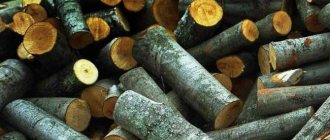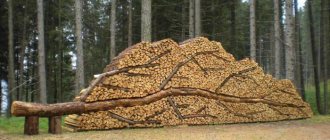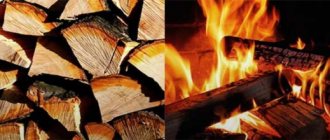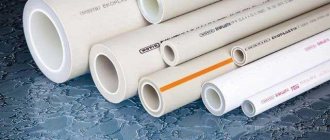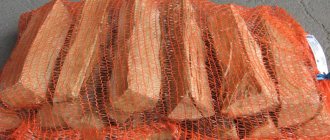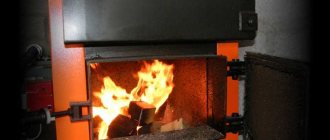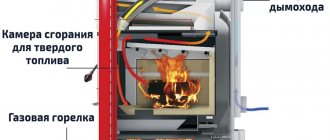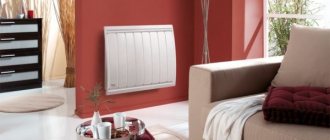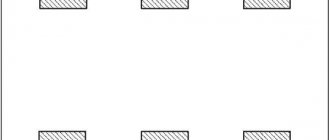If your dacha has a stove, fireplace or sauna, it’s never too early to think about buying firewood. But before you spend money on a machine of logs, think about whether you chose the right wood for kindling?
He threw logs into the firebox, saying: “Burn it with a blue flame,” and sit back and enjoy the warmth and comfort. But that was not the case... If the firewood is chosen incorrectly, you will have to “enjoy” smoke and a chimney clogged with soot. Wood of different species differs in a whole list of characteristics. Let's look at the strengths and weaknesses of the most popular options.
Birch firewood
Application : for stoves in the house and bathhouse for heating and creating a pleasant aroma.
Birch is a hardwood species. If the affordable cost of raw materials, heat and burning time are important to you, then this is the best option.
"Pros" of birch
- Doesn't cause any trouble in preparation . The fibers, although strong, are located longitudinally, so chopping birch firewood is not difficult.
- It has a pleasant and healing aroma . When burned, it disinfects the air. Helps prevent colds and has a beneficial effect on the body as a whole.
- Flames easily . The logs are covered with birch bark, which is highly flammable. The fire passes from it to the log itself. For quick kindling, place the firewood with the birch bark side down. It is not difficult to light a birch tree, even if it is damp.
- Gives good heat . In terms of thermal characteristics it is second only to oak. Burns with an even flame and does not spark. Long combustion and high calorific value allow you to warm up the room using less wood.
"Disadvantages" of birch
- Doesn't last long . After two years of storage, it loses its aroma and begins to rot.
- Gives a lot of ash . This is the main reason why birch is not often used for making barbecue. The ash scatters and settles on pieces of meat.
- Contains a lot of tar . This is a combustion product that is harmful to health and clogs the walls of the chimney, settling on them in the form of soot and soot.
Soot deposited in a thick layer can ignite and cause a fire. As it accumulates, it narrows the passage of the chimney, which impairs draft and increases the risk of carbon monoxide poisoning. In addition, excess soot increases the load on the firebox, and it breaks down faster. To avoid clogging the chimney, it is recommended to combine birch firewood with aspen wood.
How to prepare material
Dry wood is better suited for burning in a fireplace. A fifth of the moisture remains in the raw material after 2 years of drying the wood outside. It is recommended to dry in woodpiles stacked under cover, in which the chopped logs are well blown by the wind:
- the length of the logs should not exceed 40 cm. The optimal option is 3/4 of the width of the firebox;
- the diameter of firewood that ensures good combustion is 6-8 cm;
- in a woodpile, it is advisable to alternate the longitudinal and transverse arrangement of logs every 1 row.
Free air blowing over the wood promotes drying of the raw material. Oak firewood is dried for 2 years before use.
Oak firewood
Application : for a fireplace, barbecue, less often for a bathhouse and heating a house (due to the high cost).
Only Russians can afford the luxury of heating the stove with oak wood. Throughout the world, wood of this species is considered elite and is used primarily for making furniture. A machine of oak logs will be expensive even in the Moscow region, but many believe that this is a justified expense. Especially when it comes to lighting a fireplace or open stoves for cooking.
Finding a specimen suitable for kindling is not easy. Young oaks produce little heat, while old ones produce a lot of ash, emit minimal heat and make the air in the room heavy and stuffy. The ideal option is “middle-aged” trees.
"Pros" of oak
- Has maximum calorific value . Oak wood is very durable, it burns for a long time and gives off intense heat. The coals smolder slowly. The amount of heat generated is 15% more than from birch, and 35% more than from spruce. This allows you to reduce the consumption of logs.
- Stores well and for a long time . Oak is resistant to negative environmental influences. Does not deteriorate for a long time when stored outdoors.
- It has a pleasant and healthy aroma . The soft and slightly tart aroma of oak when burned has a positive effect on the nervous system, improves health and relaxes.
- Does not emit harmful substances when burning or rotting . The wood contains no resins, and the firewood itself burns 89%, releasing only carbon dioxide. Practically does not pollute the chimney.
The ability of oak firewood to produce intense heat is both an advantage and a disadvantage. They release so much thermal energy that not every stove can cope with such a load.
"Disadvantages" of oak
- Overly strong and durable . They are very difficult to split.
- They are very expensive . The wood is considered elite.
What should you pay attention to when buying firewood?
Trees for firewood should be cut down in the cold season: late autumn or winter. This is due to the fact that the movement of sap in the wood slows down or stops, there are no more leaves, and accordingly, the tree becomes lighter. Frozen wood is easier to split, making harvesting easier. Brought firewood should be stored in a well-ventilated place.
Each type of wood has its own characteristics, both during combustion and during drying. We would like to give a few recommendations:
- If you use birch for heating, then when drying it, separate and dry a little bark separately. It will be useful in the future for lighting the fireplace.
- Immediately after purchasing, dump the firewood in the yard in a well-ventilated place and leave it there for a couple of weeks and only then start storing it in a woodpile.
- Choose firewood of medium hardness, it is easier to split.
- Remember that fresh firewood has a moisture content of 50%. They should not be used in kindling. They will become suitable for heating at a humidity of 15-20%.
- If you do not have an equipped place to store firewood, then you need to make a floor so that the firewood does not lie on bare ground.
- There must be a system when stacking firewood. There should be space between the logs for air circulation.
- There are tables with drying times for each type of firewood. But weather conditions and storage principles make their own adjustments.
The difficulties of choosing a fireplace that owners of country houses face do not end with the installation of a source of flow in the house. Issues of maintenance, firewood procurement, and maintenance arise throughout the entire period of operation. But the beauty of the fire and the warming warmth make up for all the difficulties. And joint family evenings by the fireplace allow you to forget about everything and enjoy life in nature.
Firewood from fruit trees
Application : for smoking and barbecuing, less often for fireplaces, stoves in the house and bathhouse (due to the complexity of preparation in industrial quantities).
Of course, no one specifically grows apple, pear, plum or cherry trees in order to use their wood for heating a house. But if you prune or cut down an old tree, don’t waste useful material! Using such logs for a bath or sauna, you will get really light steam and a pleasant aroma.
"Pros" of fruit trees
- Easy to prepare . Easy to chop and saw.
- Contains a low percentage of resins . Only cherries smoke. But even its soot does not lead to soot deposits in the chimney.
- Gives good heat . Apple firewood has a calorific value and releases more energy than birch firewood. Plum is also good for kindling. It contains a little moisture (about 30-35%), due to which it burns evenly with a clean and beautiful flame.
- They burn for a long time . The apple tree burns the longest, the pear a little less. Cherry also exhibits a long burn period. All this, combined with good calorific value, allows you to reduce fuel consumption to maintain heat in the house.
- They emit a pleasant aroma . Branches of apple, cherry and other stone fruits are often used for smoking food and for making barbecue. One of the best options for charcoal-grilled meat is pear. It has a lower combustion temperature (670 degrees) compared to apple or birch, so it does not dry out the meat.
"Disadvantages" of fruit trees
- Cherry smokes a lot . Therefore, it is not used for kindling.
- Complexity of procurement in large volumes . The purchase price is high.
Do not allow wood to burn too high
There are three wood burning modes: low, high and optimal.
When the mode is reduced, the firewood does not burn completely and produces a lot of soot. If it is higher, you waste firewood: part of the heat flies away through the chimney, since the heat exchanger and the room do not have time to remove it completely. This occurs in two cases: you use too much wood or supply too much air. It is necessary to reduce the volume of the bookmark or draft.
The best option is when the wood burns in the optimal mode: not weakly and not strongly. The easiest way to determine the combustion mode is to use a combustion indicator, which shows the current mode in real time. If the temperature of the flue gases is more than 320 degrees, then the firewood burns at high speed.
The combustion indicator determines the flue gas temperature and combustion mode in real time
Alder firewood
Application : for baths (they give an invigorating aroma and light steam), for cooking meat on coals and smoking, for fireplaces, as well as stoves (in combination with birch, oak).
It is believed that alder was used for stoves in rich estates. And a sauna with such wood is a proven means of preventing colds. It is easy to distinguish alder logs from other species: fresh cuts have a characteristic red-orange color.
"Pros" of alder
- Easy to process . It pricks, saws and cuts without much effort.
- Does not form soot . Alder firewood, on the contrary, “burns” soot out of the chimney, cleaning it.
- Contains little resin . When burning, no acrid smoke is released. The low resin content of alder is a pleasant bonus for those who use this wood to heat their bathhouse. The air in the steam room is not filled with soot, which means there is no need to open the doors and release heat along with the smoke.
- Burns well and for a long time . Firewood flares up quickly and produces a low flame, so it is good for fireplaces and especially for barbecues. When burned, they crumble into a mass of hot, long-burning coals.
- They have a pleasant aroma . Wood of this species is especially good for heating a bathhouse. And alder branches, along with birch branches, are often used for brooms.
- Well kept . Under natural conditions it is stored for at least 3 years without loss of natural properties, incl. aroma. When wet, it dries quickly, especially compared to oak and birch.
The listed characteristics are characteristic only of alder wood, which grew in dry places. If a tree has spent its entire life in a swamp, it can smoke and produce heavy steam in a bathhouse.
"Disadvantages" of alder
- Risk of buying low-quality firewood . If alder grew in a swamp, it turns from a “royal” fuel into an extremely poor option for lighting a stove and fireplace.
- Low level of heat transfer . Alder is rarely used as the main type of fuel. Most often it is combined with birch.
Low calorific value is a relative minus. Due to this, alder is suitable for fireplaces that are not designed for very high temperatures.
Using wood as fuel
Nothing beats a real wood fire. The characteristic crackling sound and live flame are only possible if real logs are used.
There are several nuances on how to properly heat a fireplace with wood:
- It is necessary to follow the rules for storing firewood. You can heat the room only with dry wood, which contains as little moisture as possible. Firewood from freshly cut trees is not suitable. You need to use logs that have been drying for at least a year. Such firewood is easy to distinguish - it has a darker shade compared to other wood, and there are several cracks on its surface. The combustion process of dry wood is characterized by a clearly visible crackling sound.
- You need to choose logs of the same size. The thickness of the tree should be no more than 6-10 cm, otherwise the log will not burn well. The length should be ¾ of the combustion hole.
- To fire the fireplace, a horizontal method of laying firewood is used. The logs are placed in the combustion hole next to each other with a gap of 1 cm. The height of the stack should not exceed 30 cm.
Another important criterion for how to light a stove is the choice of wood species for lighting the fireplace.
What wood is suitable for fireplace inserts?
How warm the room will be after lighting the fireplace, how much soot and smoke there will be - all this depends on the type of wood for kindling. You need to know exactly what kind of wood is best to burn the fireplace with. The following types of wood are used for kindling:
- Hardwood. These include birch, hawthorn, pear and apple. It is a malleable wood that burns easily. During the combustion process, a minimal amount of tar and soot is released.
- Hard rocks. For long burning, it is better to choose oak, yew and beech logs. This type of firewood is difficult to split and takes quite a long time to light. But logs will burn much longer than other types of wood.
- Softwood. Elm, cherry, cedar and fir produce much less heat than other types of wood. In addition, the logs smoke heavily and a large amount of soot and ash is formed. You should refrain from choosing such logs if the fireplace chimney has a rectangular shape and a small hole. If the air duct draft is weak, smoke can fill the room.
- Coniferous species. To create a pleasant aroma in the room, pine and spruce logs are used. Coniferous trees burn quickly, but the flame is uneven and many sparks are produced. A large amount of smoke and soot is also released. Due to the high resin content in coniferous trees, embers may fall out of the fireplace, which is quite unsafe.
- Cleaning rocks. These include alder and aspen. Wood does not emit smoke during combustion. Using alder and aspen firewood not only does not emit soot, but also cleanses the chimney of soot. It is advisable to heat the fireplace during frequent use with cleaning logs at least once every two weeks.
- Fragrant branches. You can add fragrant tree branches to the fireplace flame, which will fill the room with a pleasant smell. You can use branches of fruit trees. Adding juniper branches to the fire will bring a healing and relaxing effect.
Whatever type of wood is used to fire the fireplace, you should choose only dry wood. If tree branches and logs contain a lot of moisture, the fireplace will become covered with soot and soot, which can weaken the draft in the chimney.
Aspen firewood
Application : for stoves and fireplaces to remove soot from the chimney. It is used extremely rarely for full heating of a house.
Aspen logs used to be considered "poor man's firewood." But you should not be too biased towards this raw material. Aspen, like alder, has cleaning abilities, removing excess soot from the chimney.
"Pros" of aspen
- Clears the chimney of soot . Aspen not only does not produce soot itself, but also removes soot after using other types of wood. The flame makes the soot loose, and it falls into the firebox.
Always have a small supply of aspen firewood. After the main fuel has burned out, place several aspen logs on the coals. They will give off a high flame of red-blue tint, and the tongues will “lick” all the soot and fumes.
"Disadvantages" of aspen
- Has low heat transfer . It is quite difficult to light aspen, but it burns out quickly and does not form coals. It produces little heat: its heat output is approximately 40% lower than that of birch.
- Produces a high flame . If this is a “plus” for cleaning the stove from soot, then for cooking a barbecue it is an unconditional “minus”.
Wood species
The main factor influencing the calorific value of a tree is its species. All types of wood are divided into deciduous and coniferous. Deciduous trees are the most effective as fuel material. Wood species vary in density and are therefore suitable for different purposes. There is also a classification here.
Conifers
Due to their low cost and availability, coniferous trees are most often used as heating material. But the properties of coniferous species leave much to be desired. The main negative feature is the presence of resins in large quantities. When burning, the resin boils, expands, and burning fragments fly in different directions over long distances. In addition, chimneys and fireplaces quickly become clogged from burning and soot. At the same time, coniferous trees have low calorific value.
Deciduous
These are the most efficient breeds for firebox needs. Depending on the density of the wood, they are divided into three categories.
- Soft. Poplar, willow, linden, aspen, alder. Due to their rapid burning, these rocks are not of great value as fuel material.
- Medium density. Larch, maple, acacia, birch, cherry. These are energy-efficient rocks, with a density approaching that of solid rocks.
- High density. Oak, hornbeam, dogwood, walnut, beech, yew. These are wood species with maximum calorific value, but due to their high density, processing of these species is very difficult.
The high cost of dense wood species is explained by their efficiency. However, as a result, this will help you save on purchasing less firewood.
Coniferous (pine, spruce) firewood
Application : for stoves (with strict adherence to safety precautions, since firewood sparks strongly, and coals can fall out of the firebox; regular cleaning of the chimney is also required); for a bath.
In our latitudes, the most common conifers are spruce and pine. Therefore, it is these species that are most often meant when you are offered a machine of coniferous firewood. They are inexpensive, but don’t rush to rejoice. They are far from ideal for kindling.
"Pros" of conifers
- They flare up quickly and give off a lot of heat . Pine is superior to spruce in terms of heat transfer due to its higher resin content. However, this wood also produces more soot.
- They crackle pleasantly when burning . The characteristic crackling sound from burning coniferous trees cannot be confused with anything else. It creates a special coziness in the house, especially on cold evenings.
- They have a pleasant aroma . Conifers are valued for their unique aroma, which has a positive effect on the upper respiratory tract. It is better to add pine “relaxants” towards the end of the kindling.
"Disadvantages" of conifers
- They burn out quickly . You often have to add wood to the firebox.
- They smoke heavily when burning . Due to their high resin content, they form a lot of soot and soot.
- Create a fire hazard . The spruce “shoots” sparks, and the pine smokes.
The radius of fire from spruce sparks is quite high, so when lighting the fireplace, remove all flammable materials from the “affected zone.” Safety precautions should also be observed when heating the stove, because... Coals may fall out of the firebox.
Fireplace insert with coal
For more warmth, it is good to heat the fireplace with coal. Only the material should be purchased specially, adapted for lighting a fireplace. First you need to create heat using firewood, on which coal is placed on top in small pieces, gradually increasing its size.
It is more difficult to light a fireplace with coal than with wood. Often special tablets or liquid for kindling are used. Modern heating systems are equipped with gas or electric igniters, which significantly speed up the process.
Linden firewood
Application : for the bath (due to its healing aroma), for the fireplace, for cooking meat (especially pork and lamb).
Linden firewood is something of a curiosity. The wood is light with a pleasant light pinkish tint and a uniform, non-fibrous texture. The material does not darken like aspen.
"Pros" of linden
- Has a healing aroma . Linden steam has a beneficial effect on the respiratory system, helps prevent flu and colds, and improves skin tone. Meat cooked over charcoal gives a slightly sweet flavor.
- Gives even heat without flashes . Produces even heat throughout the combustion process. This is ideal for heating steam rooms.
- Doesn't crack or spark . Gives a picturesque flame with tongues of lilac-greenish tint.
"Disadvantages" of linden
- Doesn't light up well . Lighting a linden tree is a troublesome task. Even dry trunks are caught in flames rather poorly. Therefore, you have to use thin splinters or wood chips, and then add small logs.
- Belongs to low-heat breeds . Calorific value – only 2040 kcal/cub.m. This means that this firewood is definitely not for heating a house in cold weather.
- Burns out quickly . Due to its low density, linden has an average burning time. It is not one of those breeds that you can put in the firebox and forget about the stove for half a day.
- Subject to rotting . It is stored for about 2 years. Requires a dry, ventilated area.
If you have a brick oven
Masonry structures are characterized by high heat capacity and inertia; it takes at least half an hour to sufficiently heat the walls of brick ovens.
This is not considered a disadvantage, since after combustion ends, brick walls retain heat longer and slowly release it to the house. But you shouldn’t hope for quick heating of rooms in houses with such stoves. In the first half hour after ignition, they are heated intensively - with the maximum permissible draft and inflow; after heating the walls and air in the room, the combustion parameters should be stable.
In practice, this means adding equal portions of firewood to the brick stove at intervals of at least 40 minutes, draft control (ideally, automatically, using a regulator), and rare and brief (no more than 15-20 seconds) opening of the combustion door.
The rest of the service rules are standard:
• Before each ignition, the brick stove is cleaned of ash, with special care when using other types of fuel besides firewood.
• 2-3 times a year her chimney is cleaned of soot. Preventive measures and more frequent procedures are allowed, reduction is not, every 1 mm of soot deposits reduces the efficiency of the furnace by 20%.
• At least once a year, all structures and surfaces of the brick oven are carefully inspected and, if necessary, repaired
Particular attention is paid to the masonry (gaps are unacceptable) and the area near the firebox door (cold air enters the firebox through possible gaps, which in turn leads to excessive consumption of firewood)
Important: Due to the absence of any recommendations from manufacturers, the amount of firewood placed in a brick oven is selected experimentally. The daily consumption rate is calculated taking into account the limitation in the frequency of kindling (no more than 3 times a day) and the duration of each fire within 2 hours
What kind of firewood is the most profitable?
In fact, this question is not entirely correct. Firstly, we have already figured out that there are few universal breeds. First of all, you need to consider for what purpose you plan to use the firewood.
Secondly, you need to clearly understand what exactly you mean by “benefit” - cost or the main characteristic of firewood - calorific value. It is most logical to compare the efficiency of raw materials by choosing a conventional unit. Let it be 1 cubic meter of the most popular material for kindling - birch. So, 1 cubic meter of birch logs is equal in efficiency to:
- oak firewood - 0.75 cubic meters;
- alder firewood - 1.1 cubic meters;
- pine firewood - 1.2 cubic meters;
- spruce firewood - 1.3 cubic meters;
- aspen firewood - 1.5 cubic meters.
The weight of the wood has nothing to do with the debate about which species is “the most profitable.” After all, when selling, the size of a product is measured not in kilograms, but in cubic meters.
The moisture content of the wood also affects the calorific value. Dry firewood burns faster, produces less ash and develops a higher temperature, and is therefore more economical.
Alternative option
In city apartments, unfortunately, we cannot install a full-fledged fireplace, either open or closed, since it is technically almost impossible to do this. At the same time, we can easily install a bio-fireplace that runs on alternative fuel.
To create a full-fledged ambiance, you should use ceramic firewood for a biofireplace, which, along with other decorative accessories, are sold in appropriate stores. Made from ceramics and properly painted, decorative firewood, logs or coals will perfectly complement the live fire of a bio-fireplace, and you will receive a full-fledged aura of comfort, coziness and warmth.
We hope that after reading this material, you have no questions about what kind of firewood is best to use to light a fireplace. Use dry and high-quality wood to get maximum results.
Wintering
Cypress pea boulevard is a cold-resistant plant; in winter it is covered only for the first few years of its life. They are covered in order to protect from sometimes too bright rays of the sun; they can be covered with fabric materials.
If you grow this plant in a cold climate (Siberia, the Urals), it must be planted in huge pots and taken outside in the summer.
It is impossible for him to live outside in winter. In the south, the tree does not require any protection and grows quietly in open areas. Date: September 25, 2022
Wood Density
Of course, in a pinch, any kind of firewood is suitable, including that obtained from a broken wooden box. But if we are talking about constant heating, then it is better to choose wood species characterized by the highest heat transfer. The heat transfer coefficient depends on several factors, including the density of the material.
Hardwoods are the same ones that are widely used in construction and decoration: oak, birch, beech. The greatest heat transfer is characteristic of oak, but since oak belongs to the category of valuable wood species, it is rarely used as fuel
It is worth paying attention to birch trees: birch produces 18% more heat than pine, and 25% more heat than aspen. This is ideal for the oven
- Medium-hard - these include coniferous species - spruce, pine, larch, and fruit tree species - apple, pear. Logs made from them provide less heat, but flare up quickly and spread a wonderful aroma.
- Soft ones - alder, aspen, are characterized by low heat transfer, but, due to the low moisture content, they burn with almost no soot formation. Such firewood is perfect for a fireplace, since the latter often serves as a decorative element rather than as an actual source of heat, like a stove.
It is no secret that logs made from freshly cut wood, regardless of the type, burn poorly: they do not flare up for a long time, produce less heat, smoke, and so on. In order for the combustion process to provide maximum heat, the wood must be well dried. The moisture content should not exceed more than 15-20%
To determine the degree of dryness, you can conduct a sound test: if a ringing sound is heard when two logs collide, then the firewood is ready for use.
